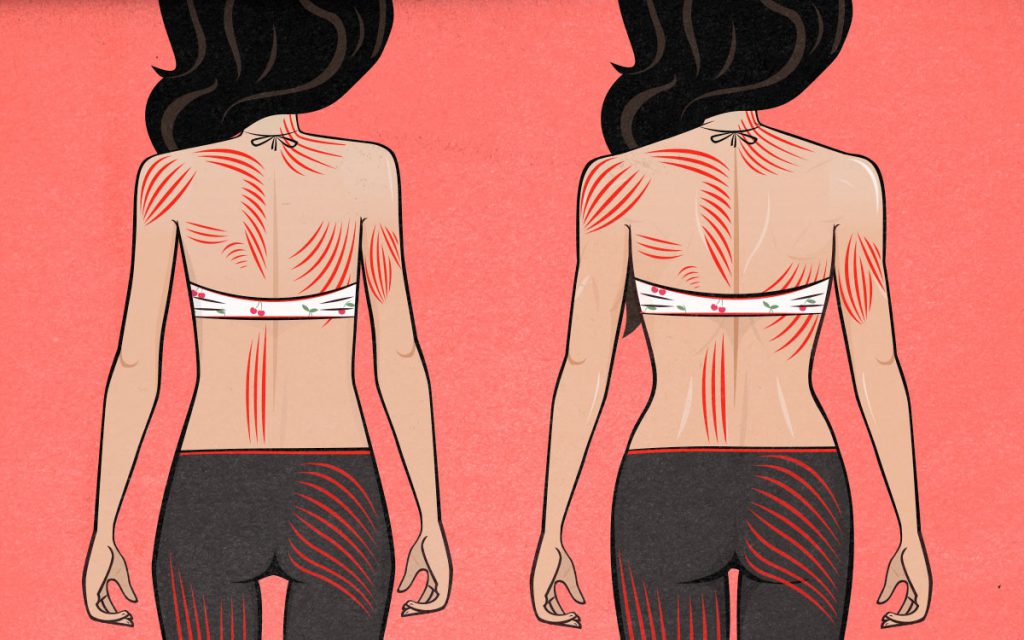
The Best Muscle-Building Exercises For Women
One of the most common questions we get asked by women is, “What’s the best exercise to grow my bony butt, hips, calves, thighs, arms, etc.?” Let’s take a look.
- The Top Muscle-Building Exercises For Women
- What Goes Into Good Exercise Selection?
- Experience Level & Muscle Gain
- Female Muscle Gain At Home
- How To Gain Muscle Fast As A Woman
The Top Muscle-Building Exercises For Women
Infographic / Illustration

We made this infographic for our Bony to Bombshell Pinterest page. If you have Pinterest, perhaps you want to give us a follow.
The Best Exercises For A Female Lifter
- Shoulders (Front & Side Deltoids)
- Front Raises
- Lateral Raises
- Dumbbell Bench Press
- Chest (Pectorals)
- Dumbbell Pec Fly
- Pec Machine Fly
- Push-Ups
- Dumbbell Bench Press
- Barbell Bench Press
- Triceps
- Cable Pushdowns
- Close-Grip Push-Ups
- Biceps
- Cable Curls
- Dumbbell Curls
- Forearms
- Abs
- Dead Bugs
- Front Planks
- Obliques
- Side Plank
- Pallof Press
- Back (Lats / Traps / Rhomboids)
- Quads (Front of thighs)
- Dumbbell Step-Ups
- Dumbbell Goblet Squats
- Barbell Front Squats
- Machine Leg Extensions
- Hamstrings (Back of thighs)
- Dumbbell Romanian Deadlifts
- Barbell Romanian Deadlifts
- Machine Leg Curls
- Glutes / Butt
- Barbell Glute Bridges
- Barbell Hip Thrusts
- Single-Leg Hip Thrusts
GET THE GOOGLE SPREADSHEET OF THE
FREE female BEGINNER’S FULL-BODY WORKOUT
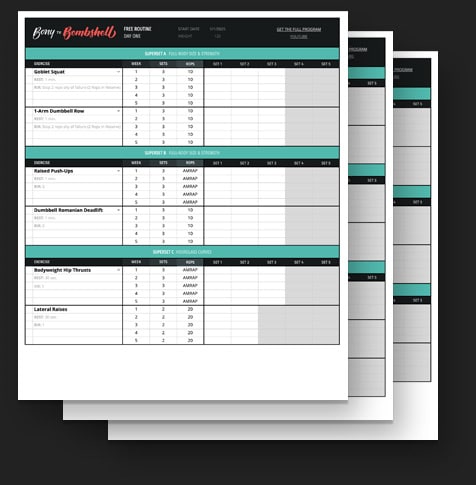
Get the workout as a Google spreadsheet. You’ll be able to pick from exercise alternatives, fill out the sheet, and get our beginner’s warm-up.
Plus, we’ll make sure you’re on the Bony to Bombshell newsletter, and send you all of our best women's muscle-building content.
What Goes Into Good Exercise Selection?
While there are tons of studies looking into what exercises activate the muscles the most, that’s just one factor that goes into deciding what exercises are the best for women who want to gain muscle.
There are many things to consider.
- Experience level and lifting skill. A beginner will do better with a less complex lift. A seasoned lifter might need a technically more demanding lift to continue to progress.
- Loadability. Some exercises are great but are hard to continue to load. For example, chin-ups are amazing for the back, but for many women, they find it difficult to even do 1-rep. That means it is not easy to adjust the “load” of the weight. It would be better to do a 1-arm dumbbell row, where you can easily select the weight.
- Range of motion. The bigger the range of motion, the more three-dimensional the muscles will look. A front-loaded squat like a front squat or goblet squat will allow a woman to squat more deeply than a barbell back squat.
- Unilateral vs bilateral. In general, unilateral work will translate to better athleticism. This doesn’t matter as much for muscle growth, but it can be useful to include for programming variety. For example, a Goblet Squat is bilateral, but a Bulgarian Split Squat would be unilateral.
- Open chain vs closed chain. If your body moves, the kinetic chain is closed. If you are stationary but a weight moves, the kinetic chain is open. For example, a push-up is a closed-chain exercise, and the dumbbell bench press is an open-chain exercise. Closed-chain exercises are generally best for joints as the movements are more natural. This also makes them more intuitive.
Experience Level & Muscle Gain
Are barbell back squats an excellent lift for women trying to build up their quads and glutes? For sure.
But it’s also an extremely complex lift. Aside from needing to set up the barbell and safety arms/pins, they must learn how to brace their core, keep their ribs glued down towards their pelvis, and keep their back from excessively arching. Many beginners feel pain when jumping into a complex exercise like this. They might feel a pinch in their back or pain in their tailbone.
But if you do a simpler lift, like the dumbbell goblet squat, because the dumbbell is in front of your body, it makes your body stay more upright. This allows the entire squat movement to work better. This also gives your glutes and quads a greater range of motion, allowing for even better muscle growth. Because you’re using a dumbbell, there’s less weight sitting on your spine, causing less joint and back pain at first.
Goblet Squat Video Demonstration
So a simpler lift can be better for building muscle if it allows you to do the form properly, allowing you to hit the muscles you’re trying to grow. There’s also less risk of injury, allowing you to keep exercising long enough to reach your goals (and beyond!).
Female Muscle Gain At Home
You Don’t Need Equipment—Just Weight
If you’re a total beginner, you don’t need a lot of equipment to build muscle. It’d be better to pick an exercise that is just enough to stimulate your muscles to grow, without needing to invest a lot of money for a squat rack, a barbell, and lots of weight plates. You can do all your lifting all at home.
Take a goblet squat, for example. While it’s true that you can’t hold as much weight as you could load up onto your back with a traditional barbell back squat, it has many advantages over the back squat.
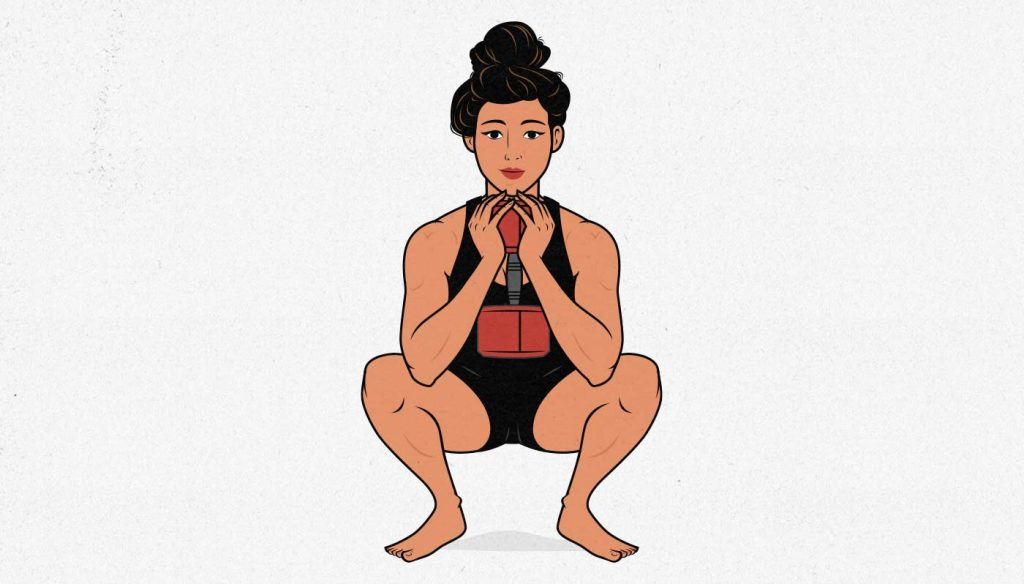
Someone working out at home could totally do this lift because it doesn’t require lots of equipment. You don’t need a squat rack, a barbell, lots of weight plates, or even a lot of space.
All this lift requires is a dumbbell or kettlebell. This makes it a great option for those who work out from home or those who just want to get started and are shy in the gym. We have many members who have just bought 3 kettlebells—light, medium, and heavy—and have them tucked away in a closet.
So the first thing to decide is if you want to build a barbell gym, buy a couple of adjustable dumbbells, buy a few kettlebells, or if you want to start with just your bodyweight.
No Equipment Exercises For Women
You don’t even need adjustable dumbbells or kettlebells. You can use your own body weight as the weight. Here are some examples:
- Chest / Triceps
- Raised Push-Ups
- Push-Ups from the floor
- Back / Biceps
- Curl and row something heavy—like a 4L / 1 gallon water jug
- If you have access to a pull-up bar, lowered chin-ups work great
- Abs
- Dead Bugs
- Flutter Kicks
- Leg Raises
- Thighs
- Bodyweight Squats
- Bodyweight Split Squats
- Glutes
- Hip Thrust on edge of Couch
- Single Leg Hip Thrust
When you can do more than 15-20 reps, it’s time to make the exercise harder. Then you can switch to doing one leg at a time. For example, you could do the Single Leg Hip Thrust—here’s Marco demonstrating it:
How To Gain Muscle Fast As A Woman
Choosing the right exercises is just one part of the battle when trying to gain muscle. You’ll also want to learn about rep ranges, amount of total sets, progressive overload, eating enough protein, eating enough calories, and getting enough sleep. For an overview, see this article “How to gain weight and build muscle for females.”
But there’s still more we can cover about using exercise to drive muscle growth.
Compound Versus Isolation Lifts For Building Muscle
To build muscle, you’ll want to optimize the “three M’s of muscle.” That’s mechanical tension, metabolic stress, and muscle damage (study). You can do this best by using a heavier weight (appropriate for your experience and strength) through the main movements.
Those movements would be something like the Romanian deadlift (hip hinge), a goblet squat (squat), single-arm dumbbell row (upper-body pull), dumbbell bench press (upper-body push), any anti-rotational exercise, and a farmer carry (loaded carry).
A good workout will have a mix of both compound and isolation lifts for your entire body. There is evidence in research that doing both helps to build more evenly developed muscle mass, more muscle mass overall, and more strength too. (study, study).
There’s even research showing that adding some isolation exercises on top of your compound exercises can help you reach your goals faster. We know that you might not be trying to build your biceps as a woman, but we can learn from this study. It shows that while chin-ups (compound exercise) were great for building up biceps, doing both compound and isolation exercises like the bicep curls, resulted in the most arm growth.

With all that in mind, you’d begin your workout with the heavy compound lifts and then finish with the lighter accessory/isolation lifts.
For example, you may find that doing 8–10 reps of the goblet squat for a few sets will help grow your glutes pretty well. But you don’t need to stop there.
You could finish with some additional lighter isolation work, such as a higher rep glute bridge, some clamshells with resistance (a band, a light weight held in place on your leg, or pushing against your hand), etc. for even more glute growth.
Glute Bridge Exercise Demonstration:
Clamshell Exercise Demonstration:
Progression And Variety Helps When It Comes To Building Muscle
The best way to stimulate every part of your muscles is to do a wide variety of great exercises that hit your muscles in slightly different ways.
But it’s important that you don’t switch your exercises too often. When you learn a new lift, you’ll adapt by improving your coordination through practice. Once you’re good at doing the lift, you’ll adapt by building more muscle. If you keep switching your exercises before getting good at them, all you’ll be doing is improving your coordination, not gaining muscle.
Try sticking with an exercise for 5–10 weeks before progressing to a new one.
And when you decide to progress to a new one, it can help to progress slowly to get what you can out of each exercise, to minimize frustration, and to reduce the chances of injury.
Alter your grip, hand position, or stance
Altering your grip will hit different fibres of your muscle and even muscle groups. There are 3 types:
- pronated, also known as overhand
- neutral grip
- supinated, also known as underhand
So say you’re working out your back with a cable row—you can hit different parts easily just by switching up your grip after you’ve done one grip for a few weeks, such as the cable row with neutral grip.
You can also switch up your hand position. When it comes to something like a push-up, bringing your hands closer together into a diamond position will put a bit more stress on your triceps on your arms. If you flare your elbows out wider, it’ll hit your pecs in your chest area a bit more.
Lastly, you can switch up your stance with your feet. When it comes to something like the deadlift, a hip-hinge movement, you can grab the weight between your legs and stand wider like the dumbbell sumo deadlift exercise. This will keep you more upright and can be a simpler exercise to start with for those with back issues or who are beginners and still building up the muscles in their lower back. Being more upright would work your quads (front of your thighs) a bit more, too.
Dumbbell Sumo Deadlift Exercise Demonstration:
As you continue to get stronger and want to progress, you could stand narrower and grab the weights on the outsides of your legs. This would make your upper body more horizontal (bent over) as you pick up the weight. This would work your lower back (spinal erectors, etc.) and your hamstrings (back of your thigh) a bit more. If the barbell or dumbbell is too low for you (long legs) or you have limited mobility, you could do raised deadlifts and move the weight up off the floor to keep the progression in smaller steps.
Same hip-hinge movement, but different muscle groups and muscle fibres are being worked.
Change The Angle Of The Bench
The best example of this would be taking your dumbbell bench press exercise and just changing the angle of the bench. Using a flat bench would be hitting your pecs pretty evenly. If you change the bench to sit up a bit and do the incline dumbbell bench, it works your shoulders and upper pec fibres a bit more. You can even do the decline dumbbell bench where it’d hit your lower pecs a bit more.
Passive VS Active Muscles For More Variety
You can use passive tension to target muscles. It’s when you use your muscles like a slingshot being pulled back. A great example would be a Dumbbell Romanian deadlift, where your hamstrings will be stretched out and then fire very efficiently (study).
You can also use active insufficiency to target some muscles by slackening others. So in a hip thrust, your hamstrings will be shortened when your knees are bent, making them so they can’t fire as well. This will allow your glutes to take over and do most of the work, which will help an advanced lifter get the stimulus they need.
If you liked this article, you’d love our muscle-building newsletter. We’ll keep you up to date on all the latest muscle-building information for women. Or, if you want us to walk you through the process of building muscle, including teaching you the lifts, giving you a full workout program, a complete diet guide, a recipe book, and online coaching, check out our Bony to Bombshell Program.


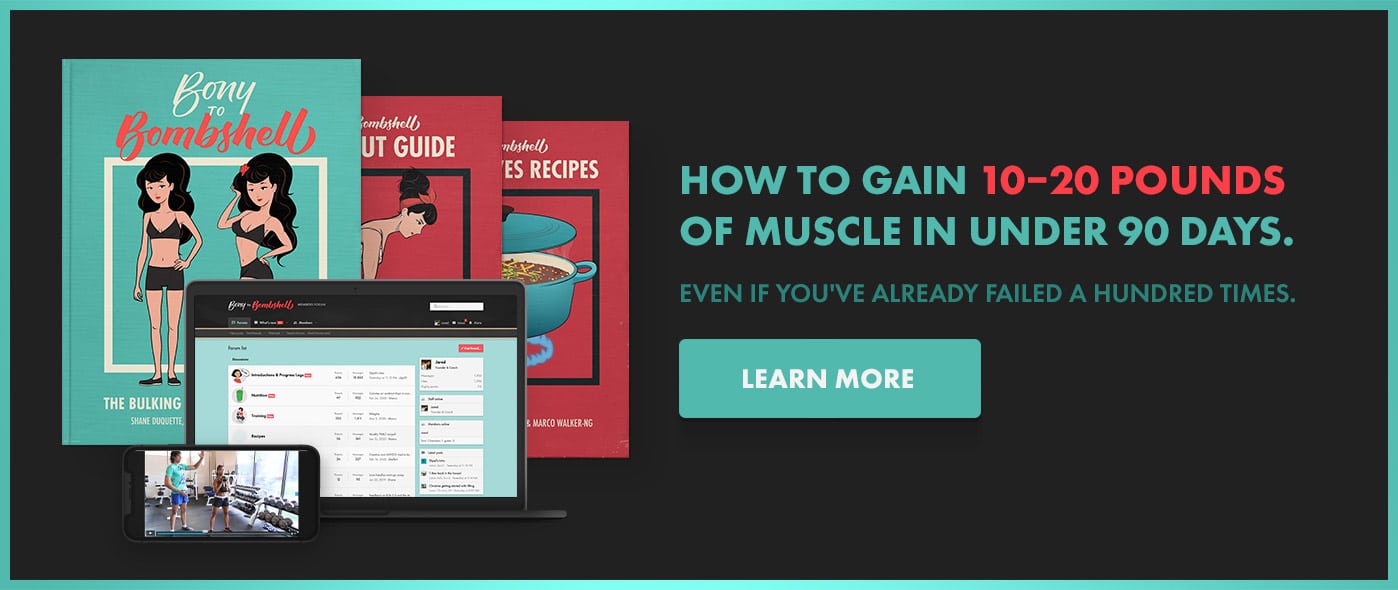
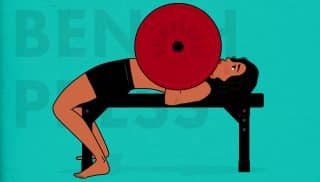
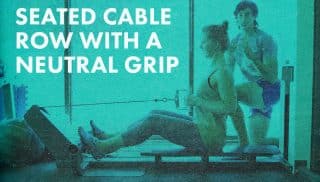

I need help !! I really want to order this however I am a vegeterian ,will the nutrition plan help me ? I know the nutrition is an important part of seeing results and most of the nutrition plans have meat incorporated . Would your nutrition plan work for me ?
Thanks
Hi Marisol,
Absolutely! Our nutrition program is quite flexible. In fact, some of the women who have their transformation on the sidebar eat a vegan diet, which is a bit more difficult than a vegetarian diet when it comes to building muscle and gaining weight (requires a bit more effort). Vegetarians (and vegans) can build lots of muscle 🙂 I hope you decide to join in!
I’m interested in this program, however, would this program work for someone who is skinny fat? My body shape is long and lean but in the last year, I’ve put on weight in my midsection ( mostly upper body) due to age and poor eating habits. I’ve started working out and eating clean but feels like the fat is here for good 🙁 or at least its not coming off as easy as in my early twenties. Basically, I would like to lose fat in my midsection and upper body and gain muscle in my lower body. Would this program benefit me as I don’t see any models on your page who carry weight in their midsection?
Thanks 🙂
Hi Sarah,
Absolutely. On the program info page we say we can help you build up 10 pounds of lean mass and lose 5 pounds of fat. Many of our members start off by burning some fat first. Our program does really well with skinny-fat bodies.
I am not sure where you are currently at, but on the sidebar Erica, Reetta, and Randi all started by losing weight. We have some more examples on our Instagram, which you might find someone in a more similar starting point: https://www.instagram.com/p/BF4T17ToiO9/?taken-by=bonytobombshellblog
Lastly, our program has a 180-day guarantee and comes with coaching. You are totally encouraged to grab the program and check it our first before deciding if it’s a good fit. You can even try it out for a month or two and see if you like how it’s working 🙂
I hope that helps a bit Sarah, we hope you decide to join!
I absolutely love this! I do have a few concerns though, I am vegan and I do already have a big enough butt for my size. The only thing I want to gain a substantial amount of muscle in are both of my legs. Like 10-15lbs in each leg. I would like wider hips and huge quads and calves (and everything in between). I do not want to look like a body builder, just very “thick”. Is there a specific program from just gaining in the legs and not the glutes.
Hmmm. That wouldn’t be our program as it hits the glutes pretty hard. Athletically and functionally you’ll want your body to work well as a unit and be balanced. So compound exercises like a squat would be great to start with. While it hits your glutes, it’ll also hit your quads a ton. Then after getting in some compound work, do some isolation exercises to target those areas for a bit more growth. For the back/front of your thighs it’d be something like leg extensions and leg curls, etc.
I’m very interested in this program. Do you have to go to the gym to follow this routine?
Hey Erika,
Many of our members work out from home. You don’t need to go to a gym. But you do need heavy weights. Body weight exercises won’t be enough.
We recommend getting 2 heavy adjustable dumbbells and an adjustable bench. I hope that helps!
How can someone tell if they need to maintain their weight, gain, or lose? Thanks
Is there any way I can gain weight in terms of muscle mass and fat if I have a naturally fast metabolism? If so, how? What diet should I be on and which workouts are best? Thank you!!
It is incorrect that yoga will not build muscle. I am an ectomorph and yoga practice significantly improved my upper body strength, far beyond what traditional weightlifting ever did.
Yoga requires you to support your own body weight: plank, side plank, headstand, handstand and various other challenging balances. Yoga is the exercise that allowed me to build enough strength and flexibility to begin aerial training (i.e. pole, silks, lyra) not to mention the mental/spiritual balance.
When I was regularly practicing yoga and aerial was the most in shape I have ever been. My abs looked amazing and my arms, bum and legs were slim but toned. I looked slim but healthy and strong.
Ladies, don’t underestimate what regular yoga practice—combined with other fitness you enjoy—can help you achieve!
Hey Sasha, I think yoga is a great type of exercise! I don’t mean to hate on it at all. It’s just that it’s not a type of exercise designed specifically to stimulate muscle growth, and so, not surprisingly, it’s not ideal for stimulating muscle growth. That doesn’t mean it’s not great, though, it’s just a type of exercise with a different purpose.
I don’t mean to suggest that it’s impossible to build muscle with yoga, either. It’s just not as good as hypertrophy training. I’m not sure what type of training you were doing when you were doing traditional weightlifting, but not all types of weightlifting are designed to stimulate muscle growth either (although I’d argue that most styles of weight training are still better at stimulating muscle growth than yoga is). If you mean traditional weightlifting as in “weightlifting,” aka Olympic lifting, then that’s not designed to stimulate muscle growth either.
Also keep in mind that building muscle isn’t about becoming slimmer, it’s about becoming more muscular. Yoga is indeed better for having slim arms in the sense that it won’t build much muscle in your arms. But if you want to build bigger, stronger, more muscular arms (or glutes or whatever), then hypertrophy training would be the way to go.
What kind of equipment will I need? I have two adjustable weight power blocks that go up to 60 lbs each. I also have an adjustable bench. The power blocks are nearly impossible to hold on my hips for a hip thrust though and difficult to hold for my wrists and shoulders when doing a dead lift. My legs are strong but my upper body is weak.
Hey Erica,
Those dumbbells are perfect! And an adjustable bench is the next piece of equipment we recommend after getting adjustable dumbbells. You’ll do great with that setup.
You could try doing single-leg hip thrusts instead of weighted hip thrusts. And even if you weight the single-legged hip thrusts, the weight will be much lighter.
It’s hard to hold weights when doing deadlifts, yeah, and dumbbells can make that harder. You might want to get some lifting grips, such as Versa Gripps. They make it much easier to hold onto weights that are heavy enough to challenge your hips. Your grip will get stronger over time, too.
Hi! Can we use resistance bands for the program? Or at least start with them? Where I live adjustable dumbbells are super expensive and I don’t think I’m ready to make that financial investment yet.
Hey Nicole, I hear ya. High-quality adjustable dumbbells are definitely expensive. That totally makes sense.
We’ve written an article on resistance bands here. So far, based on the limited research we have, it doesn’t seem that resistance bands are quite as good as free weights for building muscle. They’re also more painful and finicky than lifting weihts. You can still build muscle with them, though, and they can be handy to have around. (And some people prefer resistance bands to free weights.)
The good news is there’s quite a bit of research showing that bodyweight training IS as good as free weights for building muscle. It can be more gruelling because you’ll need to delve into higher rep ranges, and it can be more complicated because you can’t adjust the load as easily, but you can gain muscle and strength at full speed. We’ve got an article about bodyweight training here. It has a full routine you can follow.
We’re working on making a version for this website, more specific to women. What I’d recommend is swapping out the vertical push-ups for bodyweight hip thrusts. Both are explained in the article. Your workout routine would look like this:
Push-up variation (e.g. raised push-ups)
Squat variation (e.g. air squats)
Deadlift variation (e.g. towel deadlifts)
Chin-up variation (e.g. lowered chin-ups)
Hip thrust variation (e.g. bodyweight hip thrusts)
If you do 2–4 sets of each exercise every workout, and you work out 2–3 times per week, you should be able to build muscle just fine.
You can swap some of these for resistance-band variations, or you can add in resistance-band exercises as desired.
Once you get into the habit of exercising and eating a muscle-building diet, you should start to see results. Maybe at that point, you’ll feel more confident investing in some adjustable dumbbells. Once you get those, your training will become faster, easier, and less painful.
You can buy the Bony to Bombshell program if you want. It comes with a full diet guide and a weight-gain recipe book. It also comes with online coaching and support. You can post your progress updates, ask questions, and get feedback as you make progress. But the workouts that come with the program assume that you have access to free weights. The bodyweight workout is free, though, and we can help you troubleshoot and adjust your workouts as you go along 🙂
I really hope that helps!
Thanks so much for your super helpful reply!